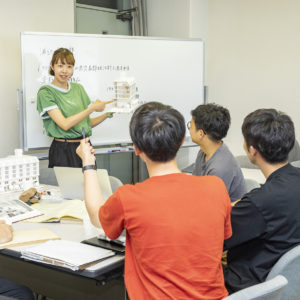Okayama Prefectural University Faculty of Design Reorganization Planning in Progress
Okayama Prefectural University was established in 1993 as Japan’s first university with a Faculty of Design. At that time, the Faculty of Design started with two departments: Visual Design, Craft and Industrial Design. With the changes of the times, two reorganizations have occurred, and currently, there are two departments: Design and Technology and Aesthetic Design. However, in recent years, in response to the strong requests from the community, the current field of Architecture and Urban Design in the Department of Design and Technology will become independent as a department. Also, since the times have significantly changed, we want to promote education in fields that include planning, sharing, and distribution, which are broad meanings of design, while enhancing expertise. Hence, in 2021, the faculty will reorganize into three departments: Visual Design, Craft and Industrial Design and Architecture.
Department of Visual Design
Develop specialists who can play an active role in the advertising and publishing industries
The Department of Visual Design pursues expertise in each field based on the knowledge and skills of visual communication that can be used in various media. The curriculum is organized based on a stacked specialized education program. The first year learns the basics of visual communication, and the second year, students can choose to specialize in graphic design or video design. In the third year, students will develop thinking skills and practical skills as they plan and develop proposals from the perspectives of the community and society to address their needs. In the fourth year, students will hone their skills through the graduation research project.
Through such education, we aim to train specialists who are active in the advertising and publishing industries such as graphic designers and video creators who can demonstrate their abilities for the sustainable development of local and international communities.

Department of Craft and Industrial Design
Integrating “plan” and “execution”
The “planning” and “execution” stages in the design are often separated in solving problems. Even in society, the role of producers and consumers are independent. Also, planning and manufacturing processes function independently. However, the recent trends showed that they are the tendency to integrate these processes. The Department of Crafts and Industrial Design aim to nurture specialists who can integrate “planning” and “execution” to contribute to the sustainable development of society by acquiring craftsmanship and industrial rationality through a three-dimensional model of education.
The curriculum is organized based on a specialized education program. The first year learns the basic knowledge and skills in design, and for the second year, students can choose to specialize in product design, textile design and ceramic design. In the third year, students will develop the ability to develop proposals to address local and corporate issues. In the fourth year, students will hone their skills through the graduation research project.

Department of Architecture
Ability to learn from regions and traditions and create new value
In the Department of Architecture, we aim to nurture specialists with extensive knowledge and advanced skills from interior design to regional planning, focusing on architectural design. Also, training architects who will contribute to the sustainable development of international and local communities.
Students will learn basic knowledge about design through common education subjects. They will acquire specialized architectural knowledge such as the expression skills, history, planning, structure and environment to apply in architecture design. Also, they will improve their practical skills through participation in local design projects and internships. Furthermore, through the graduation research projects, other than acquiring the fundamental skills in specialized knowledge and technology, they will also develop comprehensive skills like problem finding and problem-solving. We aim to nurture self-directed learners who can pioneer new eras in architecture.

2020.3.20

 Return to List
Return to List